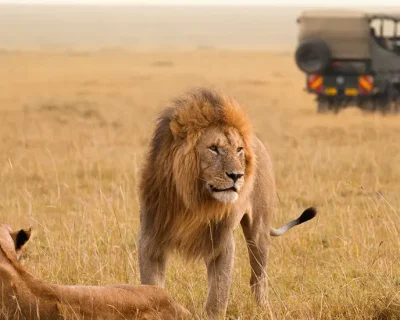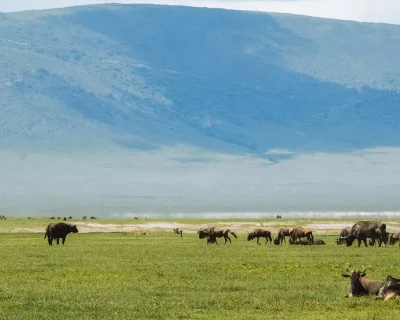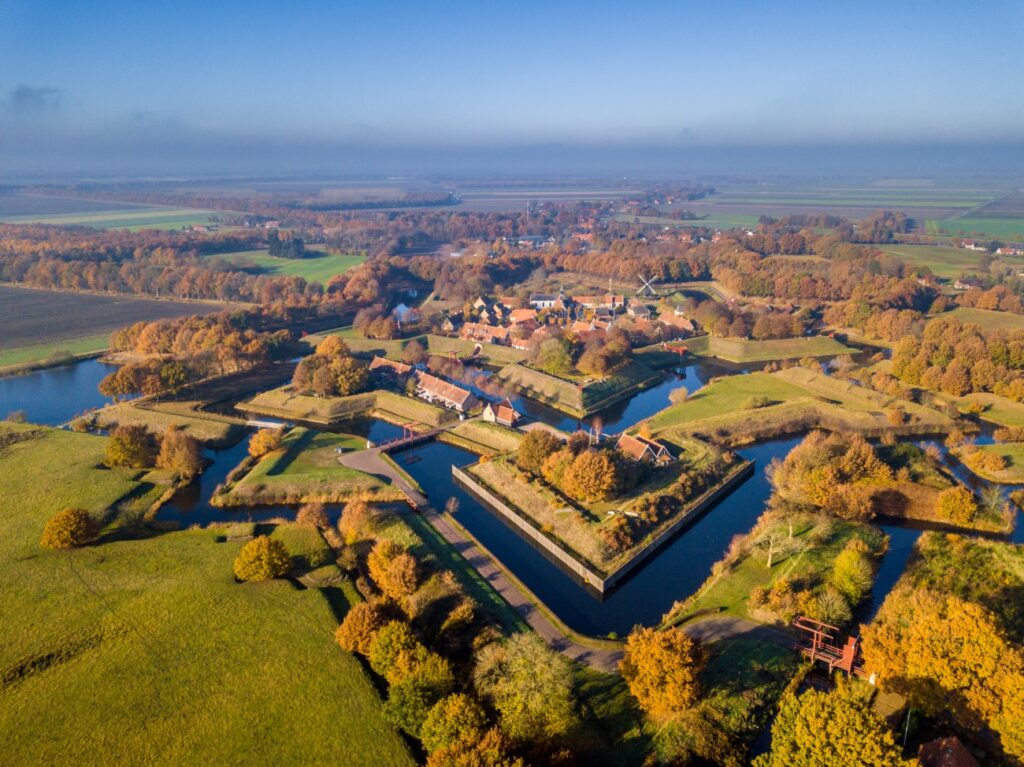Tanzania is one of East Africa’s most popular safari destinations. Think of conservation areas in Northern Tanzania like Tarangire National Park, the Ngorongoro Crater, and Serengeti National Park, which is a UNESCO World Heritage Site and the backdrop against which the Great Wildebeest Migration takes place. Here are 10 reasons to go on a Tanzania safari by Roxanne Reid of Safari Bookings:
1. Game Drive in Tarangire National Park
Tarangire is perhaps best known for its high numbers of elephants, its unusual baobab trees and the termite mounds that dot the landscape. In the dry season (June to November) you can see thousands of buffalo, wildebeest, and zebra here, as well as predators like lion, leopard, wild dog, and cheetah. Giraffe and antelope-like Grant’s gazelle are regulars.
2. Safari in Ngorongoro Conservation Area
Almost three million years old, this UNESCO World Heritage Site in the Highlands is named after the 600m-deep Ngorongoro volcanic caldera/crater. Wildlife gathers in the crater in great numbers. You can see animals like lion, leopard, black rhino, buffalo, cheetah, wild dog, zebra and wildebeest, and many types of antelope. Thousands of flamingo flock to Lake Magadi on the crater floor.
3. Safari in Serengeti National Park
Serengeti is 14 750 square kilometers of savanna, grassland, riverine forest and woodland in Northern Tanzania. It is home to the Big Five and more than 500 bird species. Although best known for the Great Wildebeest Migration (see point 5 below), Serengeti offers good game viewing all year round, especially Big Cats, buffalo, and elephant.
4. The Great Wildebeest Migration
This natural wonder of Serengeti sees millions of wildebeest and zebra migrate northwards from southern Tanzania to Kenya and then back again each year. June/July is the rutting season in the western Serengeti. From the end of July to October is crossing season, when the herds cross rivers from Serengeti into Kenya’s Maasai Mara. Predator-prey interactions are common. If you want to see the dust as the herds move and listen to the wildebeest grunting, make sure your travel operator books camps in the right areas for the month you’re traveling. Just remember that even in the peak season (June to October) you’re not guaranteed to see a river crossing; this is nature, after all.
5. Bird Watching
Tanzania is home to more than 1000 bird species, so a Tanzania safari here is a great chance to indulge your passion for bird watching. If you’re really keen, tell your guide so s/he can be sure to keep an eye out for some of the local specials.
6. Maasai Cultural Visit
The Maasai have lived here for hundreds of years. Don’t miss a visit to a Maasai village to learn about their culture and customs, the importance of their livestock. Challenge them to a jumping contest at your peril – you will lose!
7. Scenic Landscapes
Wildlife takes center stage in this northern part of Tanzania, but the landscapes make for wonderful vistas and photographs too. From grassland plains with umbrella trees, savanna and woodlands as well as granite outcrops, you’ll enjoy the diversity of landscapes.
8. Hot Air Balloon Safari
Take to the skies at dawn and look down on wildlife as you float with the wind. After you land, enjoy a slap-up bush breakfast.
9. Bush Dinner or Sunset Picnic
Succumb to the beauty of your natural surroundings while having a romantic sunset picnic as the heat seeps from the day. Or enjoy a hearty dinner by the light of paraffin lamps. Listen to the sounds of the night and marvel at the stars overhead.
10. Luxury Camps
Stay with Acacia Collections and experience the intimacy of safari camps with just 10-12 luxury tents but with all the comforts of a top hotel. Enjoy luxurious touches, superb views, and top-notch service. Choose from camps in Tarangire, Central Serengeti and near Makoma Hills in Western Serengeti. There is also a semi-permanent migration camp in the Kogatende area in Northern Serengeti to make the most of the July-October river-crossing season.





